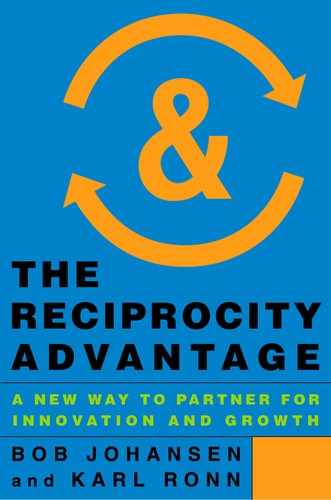PART ONE
Reciprocity on a Massive Scale
The four chapters in Part One introduce the four steps to reciprocity advantage. This four-step cycle will give you a new way to think about innovation and growth.
Chapter 1. Uncover your right-of-way—an existing platform where you already have permission to innovate with authenticity. Which of your assets have value for others and could also help you create complementary business growth? Essentially, what underutilized assets could you give away now that would yield greater value later?
Chapter 2. Find the best partners, ones who will allow you to accomplish what you could not do alone. Which partners will lower your risk, increase your innovation potential, and look out for you?
Chapter 3. Learn by experimenting. Give away assets intelligently in order to learn how to create value in new ways. The goal is to learn in an open, low-cost, and iterative way that allows for time to discover which questions to ask. How can you and your partners learn how to make money in new ways within your right-of-way?
Chapter 4. Scale it once you figure out what works, but keep it small until you are ready. The focus here is on how to make your new business big. Cloud-served supercomputing will be an amplifier for almost everything. When you are convinced that your business is desirable, viable, and ownable, you are ready to scale.
Following these four steps will help you uncover your right-of-way and create your reciprocity advantage, which will make extremely good business sense—given the external future forces of the next decade.
Creating new businesses is risky. Using your existing but underutilized right-of-way to create a new business will lower your risk dramatically. You already own the assets you are sharing or giving away, and in most cases, you are not getting any value at present from these underutilized assets. If these assets can be unleashed to create new growth and capitalize on the disruptions that will occur in the near future, you can create a reciprocity advantage.
Reciprocity advantage will scale much faster if it is grounded in trust. James Fallows, in his book More Like Us, introduced the intriguing notion of a radius of trust:
Except for psychopaths, everyone treats someone else decently. The question is how many people are classified as “us,” deserving decent treatment, and how many are “them,” who can be abused. When the radius of trust is small, the society is carved into tribes, castes, and clans. People are loyal to the handful of brothers inside the circle and may as well be at war with everyone else. The obligation to behave decently—and the expectation of decency in return—ends with family or friends. (More Like Us, p. 25)
Fallows was writing about trust in 1989. Building strong brands and strong businesses has always been an effort to build trust. What’s changing is transparency.
In the past, companies could exert considerable control over their brand story through one-way broadcast media. In the future, control of corporate stories will be very difficult and transparency will be mandated. What people say about your brand will be much more important than what you say about your brand.
In a world of increasing global connectivity, the importance of trust will increase. Transparency will be required, while control of your own brand story will be increasingly difficult. If companies are not transparent, transparency will be forced upon them and forced transparency may well be unfair. Companies will need to embrace this loss of control but figure out ways to grow even when they do not have control. If you are not trustworthy, you will not grow in this world—at least not for long.
Figure 3: Step One toward Reciprocity Advantage.

